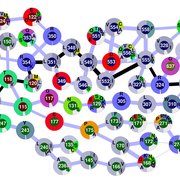


DNA is replicated before cell division so that each daughter cell has its own copy. Because very high accuracy during replication is essential for cell survival dedicated DNA repair mechanisms are coupled to replication.
The MutSLH system focuses on repairing base mismatches and base insertions or deletions. MutS is the central bacterial enzyme that scans DNA and initiates repair when a defect is found. Eukaryotic MSH homologs MSH6/MSH2 and MSH3/MSH2 have a very similar structure and function and are essential in preventing cancer that results from damaged, unrepaired DNA.
We use molecular dynamics simulation to understand how exactly mismatches are recognized and how repair is subsequently initiated via long-range allosteric mechanisms.
| 2016 | ||
| 7. | Beibei Wang, Joshua Francis, Monika Sharma, Sean M. Law, Alexander V. Predeus, Michael Feig: Long-Range Signaling in MutS and MSH Homologs via Switching of Dynamic Communication Pathways PLoS Computational Biology (2016) 12, e1005159 Abstract PDF | |
| 2014 | ||
| 6. | Monika Sharma, Alexander V. Predeus, Nicholas Kovacs, Michael Feig: Differential mismatch recognition specificities of eukaryotic MutS homologs, MutSα and MutSβ Biophysical Journal (2014) 106, 375-382 Abstract PDF | |
| 2013 | ||
| 5. | Monika Sharma, Alexander Predeus, Shayantani Mukherjee, Michael Feig: DNA Bending Propensity in the Presence of Base Mismatches: Implications for DNA Repair Journal of Physical Chemistry B (2013) 117, 6194-6205 Abstract PDF | |
| 2011 | ||
| 4. | Sean Law, Michael Feig: Base-flipping mechanism in DNA mismatch recognition by MutS Biophysical Journal (2011) 101, 2223-2231 Abstract PDF | |
| 2009 | ||
| 3. | Shayantani Mukherjee, Michael Feig: Conformational change in MSH2-MSH6 upon binding DNA coupled to ATPase activity Biophysical Journal (2009) 96, L63-L65 Abstract PDF | |
| 2. | Shayantani Mukherjee, Sean Law, Michael Feig: Deciphering the mismatch recognition cycle in MutS and MSH2-MSH6 using normal mode analysis Biophysical Journal (2009) 96, 1707-1720 Abstract PDF | |
| 2008 | ||
| 1. | Sean Law, Michael Feig: Application of a Novel Biasing Potential to Study DNA Translocation and DNA Base Flipping From Computational Biophysics to Systems Biology (CBSB08) Proceedings, John von Neumann Institute for Computing (NIC) Series, ed. Ulrich Hansmann et al. (2008) 40, 285-288 |